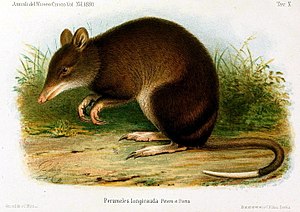Mouse nose bag
| Mouse nose bag | ||||||||||||
|---|---|---|---|---|---|---|---|---|---|---|---|---|

Long-tailed mouse nasal sac ( Microperoryctes longicauda ) |
||||||||||||
| Systematics | ||||||||||||
|
||||||||||||
| Scientific name | ||||||||||||
| Microperoryctes | ||||||||||||
| Stein , 1932 |
The Mausnasenbeutler ( Microperoryctes ) form a kind of the group of the New Guinea-Nasenbeutler (Peroryctinae). These are rainforest dwellers from New Guinea about whom very little is known.
The common characteristics of the mouse nosebags include their relatively small size, pointed snout, small ears and a long, soft fur. These animals inhabit the soil of the New Guinea rainforests at altitudes of up to 4500 meters. Little is known about their way of life: they are likely to be omnivores that feed on fruits and small animals, they are allowed to live solitary and create nests in the root area of the trees as resting places. Females with one to three pups have been found nearly all year round, which is the only evidence of reproduction.
For most species, too, no information can be given about the size of the population or the degree of endangerment.
The species
- The Arfak mouse nasal sac ( Microperoryctes aplini ) was only described as a separate species in 2004. At 14 to 16 centimeters, it is slightly smaller than the Weyland mouse-nosed pouch, from which it differs through a black stripe on the back and a white tip of the tail. Animals of this species have been found on the Vogelkop Peninsula in the far west of New Guinea.
- The long-tailed mouse nasal sac ( Microperoryctes longicauda ) is the largest member of its genus with a head body length of 25 to 29 centimeters and a weight of up to 670 grams. Its fur is reddish brown or light brown in color, some animals have black stripes along the back, on the flanks or above the eyes. It occurs at altitudes of up to 4000 meters in the central mountains of New Guinea. Microperoryctes ornata is sometimes classified as a separate species, but mostly as a subspecies of the long-tailed nasal sac, the differences are mainly in the pronounced stripes on the side flanks.
- The Weyland mouse nasal sac ( Microperoryctes murina ) reaches a head body length of 15 to 17 centimeters and a tail length of around 11 centimeters. So far only three specimens have been found in the Weyland Mountains in western New Guinea. Their fur is usually a uniform gray color, the species may sometimes live burrowing underground.
- The Mura mouse nasal sac ( Microperoryctes papuensis ) is slightly larger with a length of 18 to 20 centimeters and a weight of up to 180 grams. The fur of this species is dark gray in color, and on the back and face they have striking black stripes. Animals of this species have been found at altitudes of 1200 to 2600 meters in southeastern New Guinea.
literature
- Ronald M. Nowak: Walker's Mammals of the World . Johns Hopkins University Press, 1999 ISBN 0-8018-5789-9